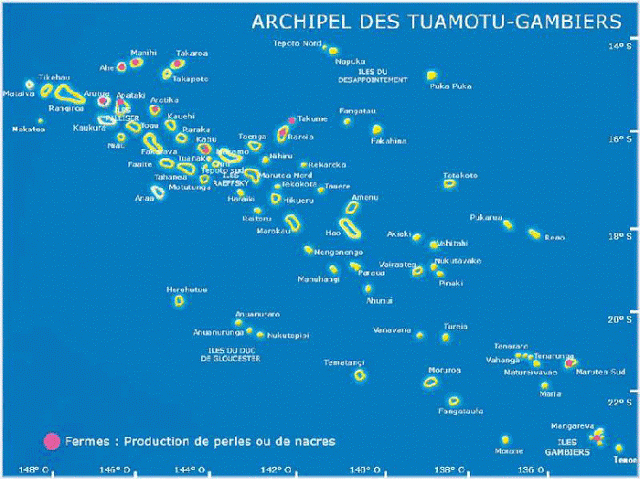
The symbol of the dream islands
Among the 118 islands of French Polynesia, 78 are
atolls and make up the whole Archipelago of the Tuamotu-Gambier.
An atoll is the oldest
geological shape of the volcanic islands. It results at the same time, from the
formation of a coral reef, surrounding an extinct volcano and combined phenomena
of erosion of the volcanic cone and its collapse on itself. So there’s left only
a ring of coral enclosing a lagoon left. It may be open or closed depending on
whether or not there are passes.
On the other hand, there are
Hoa (water passages through the motu) which allow the movement of water during
tides.
Among the 78 islands of The
Tuamotu-Gambier, 76 are atolls. The closed Archipelago of Gambier and Makatea Island
make an exception to this rule.
The Tuamotu Archipelago:
a rosary of pearls…
By the number of its
islands, such as by the maritime area occupied, the Tuamotu Archipelago is by
far the most important of French Polynesia.
 |
| Cartographic reality of the Tuamotu Archipelago |
As a huge barrier between
the Society Islands and the Archipelago of the Marquesas, Tuamotu stretch over
1,800km long and 600 wide, from north-east to south-east. They cover an area of
800,000 km2.
In the census of 2007, there
were 18,317 inhabitants throughout Tuamotu-Gambier, among which 3,384 on the
only Rangiroa Atoll.
From the largest of these
atolls, Rangiroa, the lagoon of which (second of the world) could contain the whole
island of Tahiti, to the smallest ones that are uninhabited as much as
inaccessible, it’s a recognizable pattern: the feeling of being entered a
postcard…
 |
| In Tuamotu, truth is often stranger than fiction and dream |
Lagoons with unforgettable
colors lined by white beaches, and protected from the sun by the inescapable
coconut palms, seabed incredibly rich in natural resources (animal and plant),
bird species, many of which are endemic…
And most importantly, a
wonderful people whose only kindness equals simplicity.
History and
Tuamotu
The origin of the settlement
of the Tuamotu is due, it seems, to relatively recent immigrants from the
Marquesas Islands, probably in the sixteenth century and after they would have
been made livable by the introduction of coconut.
Until 1854, the archipelago
is named Pomotu, which means
“Subservient Islands”. At that date, the French government changed it to Toamotu (“Distant Islands”) and became
Tuamotu.
Now known by sailors as the
archipelago of “Low Islands”, it has been also called for a long time the
“Dangerous Archipelago” or the same as the “Bad Sea”…
It’s on 24 January 1521 that
Ferdinand Magellan discovers Puka Puka. It’s about the first atoll of the
Pacific Ocean of being unearthed by the Europeans.
A few years later, following
the road that lead to Tahiti, Louis Antoine de Bougainville ventures successfully,
but not without dismays, into this fantastic maze of islands.
But we must wait nearly
three hundred years, on September 6th, 1839, to be precise, before
being discovered and focused on the card, the last Paumotu* atoll. It’s the atoll of Ahe, discovered by the explorer
and American naval officer Charles Wilkes.
It’s in 1844 that the
Tuamotu Archipelago became a French protectorate. Its annexation to the French
Republic is official in 1880.
 |
| Coconut grove on the Atoll of Rangiroa. |
The isolation of atolls,
their poverty and especially the danger of their waters and passes allowed them
to get somewhere safe in their lagoons and to be protected from the large
eddies of human history.
The economy in
these atolls of heaven
Life is hard on the Tuamotu atolls:
fresh water is very scarce, and there is a need to collect the rain to get
something to drink.
The Paumotu people have long
lived exclusively from fishing and about of all the wealth of the coconuts, until
the French industry is interested by the nacre of oysters of the Tuamotu, which
was long the raw material for the manufacture of buttons.
It’s only in the 1970s that
these oysters are raised for their unique-colored pearls. The pearl becomes the
main economic resource of the archipelago.
The tourism, meanwhile,
develops only on the last twenty years, severely handicapped by the scarcity of
regular means of communication. However, the beauty and richness of the dive
sites are a particularly popular destination for lovers, and there are more and
more diving-clubs, well equipped in a number of atolls like Rangiroa or Tikehau
 |
| Ocean side from a range of Tikehau Atoll |
A trip to the Tuamotu should
be earned, but it always leaves lasting memories. A stay at the Tuamotu is, for
many, the journey of a lifetime…
An article
of Julien Gué
Translated from French by Monak
*Paumotu, adj.: Everything
about Tuamotu Islands
Copyright
Julien Gué. Ask for the author’s agreement before any reproduction of the
text or the images on Internet or traditional press.



Aucun commentaire :
Enregistrer un commentaire
Cet article vous a fait réagir ? Partagez vos réactions ici :